Summary
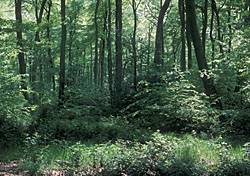 Natural regeneration is the process by which woodlands are restocked by trees that develop from seeds that fall and germinate in situ.
Natural regeneration is the process by which woodlands are restocked by trees that develop from seeds that fall and germinate in situ.
For most of the last two or three centuries foresters have restocked and created woodlands by using transplants grown in nurseries. Natural regeneration was rarely used until the late 1980s when a combination of factors, including a desire to “do things more naturally”, and a change in the grant structure, lead to its use becoming more popular. However, few woodland managers had any experience in the successful use of natural regeneration, which is much less predictable, than restocking using transplants.
Restocking by natural regeneration is often unsatisfactory, frequently for unknown reasons; which demonstrates the need for research to understand the processes occurring. After a survey, which tried to define the state of naturally regenerating woodlands, studies of the following topics were begun:
- Storm damage to woodlands in southeast England was extensive on the night of 16 October 1987 and a survey to investigate restocking by natural regeneration has recently been completed.
- Development of the ground flora can be extensive following the forest operations carried out to promote natural regeneration. The changes in the ground flora within both temporary and permanent plots have been observed at a variety of sites in order to investigate how they may influence the survival and growth of tree and shrub seedlings.
- Seedling establishment of some species has been observed by following the growth and survival of tree species growing after silvicultural operations to promote natural regeneration.
- Browsing damage by deer is a serious problem in most lowland woodlands, and it can retard or prevent satisfactory natural regeneration. The influence of simulated browsing damage on seedling growth and survival has been studied.
- Competition with other vegetation can inhibit the growth or cause the death of tree seedlings. Nursery studies have investigated the competition between tree seedlings and grass.
Lowland native woodlands – Development of the ground flora
Development of the ground flora can be extensive following the forest operations carried out to promote natural regeneration. The changes in the ground flora within both temporary and permanent plots have been observed at a variety of sites in order to investigate how they may influence the survival and growth of tree and shrub seedlings.
Research has aimed to study the change in vegetation with time, competition between the ground flora and tree seedlings, and the influence of vegetation management on seedling establishment.
Observations have included changes in the frequency and cover of both individual species and categories of vegetation within the ground flora of permanent quadrats in the years immediately after thinning or felling native broadleaved woodland or PAWS. Contemporary studies of tree and shrub seedlings made within the same quadrats will allow investigation of the relationships between the vegetation present and the establishment of tree seedlings.
Bramble is often a dominant component of the ground flora of many woodlands and its growth and development have been studied in more detail than other species. This has included a survey of tree regeneration on clear-felled sites to investigate the hypothesis that bramble may be beneficial for the establishment of tree seedlings.
Does bramble facilitate the natural regeneration of broadleaved trees? (PDF-296K).
Harmer, R. and Morgan, G. (2005). Unpublished Forest Research Report.
Report on bramble meeting (PDF-21K)
Brief notes of the presentations made at the British Ecological Society – Forest Ecology Group meeting held on 21st June 2006.
The publications include some of the experiments on this subject.
Change in vegetation – an example
These photographs show the change in vegetation present during May over a 4-year-period from one dominated by bluebells to one dominated by bramble. The plot was in a small cleared area within an ash woodland from which deer and rabbits were excluded.
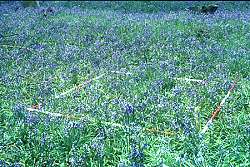
Year 1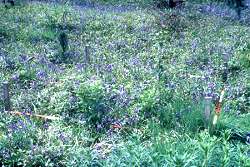
Year 2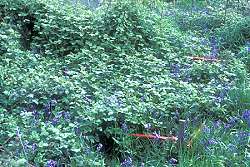
Year 3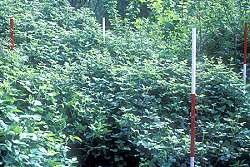
Year 4
Lowland native woodlands – Natural regeneration of broadleaved trees and shrubs – Publications
Harmer R., Kiewitt, A., Morgan, G. and Gill, R. (2010). Does the development of bramble (Rubus fruticosus L. agg.) facilitate the growth and establishment of tree seedlings in woodlands by reducing deer browsing damage? Forestry Advance Access published on January 6, 2010. DOI: 10.1093/forestry/cpp032.
Harmer, R. and Morgan, G. (2007). Development of Quercus robur advance regeneration following canopy reduction in an oak woodland. Forestry, 80, 137 -149.
Harmer, R. and Morgan, G. (2005). Does bramble facilitate the natural regeneration of broadleaved trees? (PDF-296K). Unpublished Forest Research Report.
Harmer, R., Boswell, R. and Robertson, M. (2005). Survival and growth of tree seedlings in relation to changes in the ground flora during natural regeneration of an oak shelterwood. Forestry 78, 21-32.
Harmer, R., Tucker, N. and Nickerson, R. (2004). Natural regeneration in storm damaged woods – 1987 storm sites revisited (PDF-221K). Quarterly Journal of Forestry, 98, 183-190.
Harmer, R. (2003). Seedling root growth of six broadleaved tree species grown in competition with grass under irrigated nursery conditions. Annals of Forest Science, 60, 601-608.
Harmer, R. (2002). Restocking after storm damage from an English perspective. In: Restocking of storm-felled forests: new approaches. Proceedings of an International Workshop in Denmark, March 2001. Ed. A. Brunner. Danish Centre for Forest, Landscape and Planning Report No. 12, Hørsholm, 47-52.
Harmer, R. (2001). The effect of plant competition and simulated summer browsing by deer on tree regeneration. Journal of Applied Ecology 38, 1094-1103.
Harmer, R. (2001). Thinking about using natural regeneration? Smallwoods, Winter 2001, Journal of the Small Woods Association.
Harmer, R. (2001). Dazzled by light? Continuous Cover Forestry Group Newsletter January 2001, 25-27.
Kerr, G., and Harmer, R. (2001). Potential use of alternative silvicultural systems in broadleaved woodlands. ICF News 1/2001, 3-4.
Harmer, R. and Gill, R. (2000). Natural regeneration in broadleaved woodlands: deer browsing and the establishment of advance regeneration. Forestry Commission Information Note 35.
Harmer, R., Willoughby, I. and Robertson, M. (2000). Use of herbicides to control weeds and promote the natural regeneration of Fagus sylvatica. In Vegetation Management in Changing Landscapes (ed. Boatman, N. D., Clay, D., Goodman, A., Marrs, R. H., Marshall, E. J. P., Newman, J. R., Putwain, P. D. and Pywell, R. F.). Aspects of Applied Biology 58, 9-14.
Harmer, R. (1999). Survival and new shoot production by artificially browsed seedlings of ash, beech, oak and sycamore grown under different levels of shade. Forestry Ecology and Management 116, 39-50.
Harmer, R., Kerr, G. and Boswell, R. (1997). Characteristics of lowland broadleaved woodland being restocked by natural regeneration. Forestry 70, 199-210.
Harmer, R. (1996). Growth of seedling tree root-systems in competition with grasses. Aspects of Applied Biology 44, 47-54.
Harmer, R. and Kerr, G. (1996). Natural regeneration – is more advice needed? Quarterly Journal of Forestry 90, 190-196.
Harmer, R. (1995). Natural regeneration of broadleaved trees in Britain: III. Germination and establishment. Forestry 68, 1-9.
Harmer, R. and Kerr, G. (1995). Natural regeneration of broadleaved trees. Forestry Commission Research Information Note 275 (PDF-120K).
Harmer, R. (1994). Natural regeneration of broadleaved trees in Britain: I. Historical Aspects. Forestry 67, 179-188.
Harmer, R. (1994). Natural regeneration of broadleaved trees in Britain: II. Seed production and predation. Forestry 67,275-286.
Harmer, R. (1994). Selecting sites for natural regeneration of broadleaves. Forestry and British Timber, 23, 16-18.
Harmer, R. and Forrester, M. (1994). Natural regeneration of broadleaves in perspective. Quarterly Journal of Forestry, 88, 141-144.
Harmer, R., Kerr, G. and Fisher, D. (1994). The potential for natural regeneration of broadleaves in central southern England. Quarterly Journal of Forestry 88, 297-302.
What’s of interest
For Forestry Commission publications:
On-line publications catalogue
